Menus
- 20 years of Fireblade: Part 1
- Handling course, setup and lap times
- PS data and measured values
- Technical background
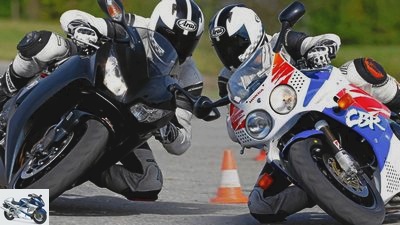
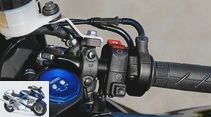

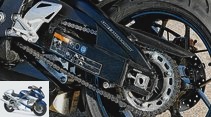

14th photos
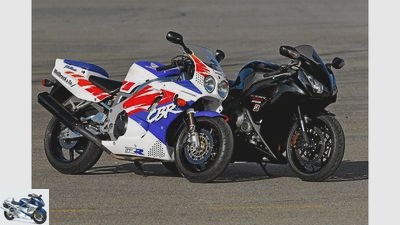
1/14
At the end of 1991 Honda presented the first Fireblade and shook the athlete Olympus permanently. We compare the Fireblade SC 28/1992 from 1992 with the current Fireblade SC 59/2012.

2/14
The switch housings of the SC 59 are unchanged, just re-assigned.
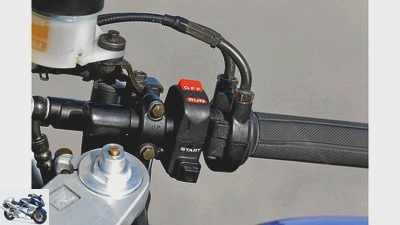
3/14
Light and kill switches were minimalist.
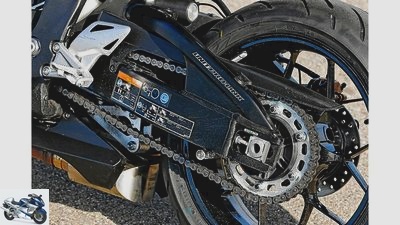
4/14
In 2012 the swing arm is 67 mm longer than in 1992.
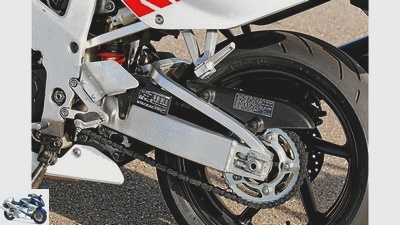
5/14
As early as 1992, the Honda had a solid aluminum swingarm with an upper pull.
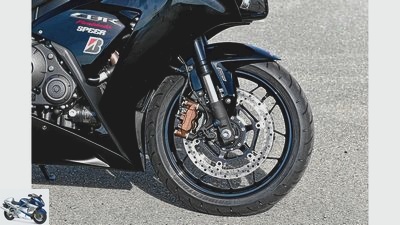
6/14
Today, however, the Fireblade is equipped with a conventional 17-inch wheel with a 120/70 skin.
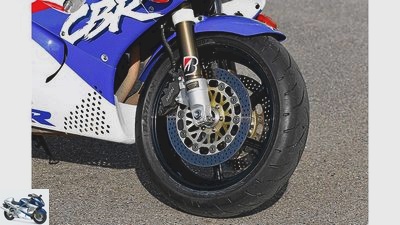
7/14
Even the 16-inch front wheel still takes some getting used to on the SC 28.
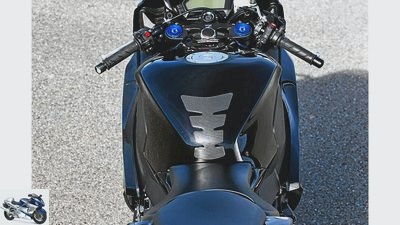
8/14
The SC 59, on the other hand, has the usual: a narrow fuel barrel for top ergonomics.

9/14
The massive tank of the SC 28 is very idiosyncratic.
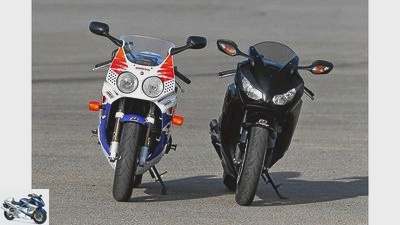
10/14
The ingenious designer Tadao Baba left the beaten track of the competition with the CBR 900 RR Fireblade and limited himself to the essentials, the fun of driving, very Japanese. In the following photos you can see the details of the Fireblade in direct comparison.
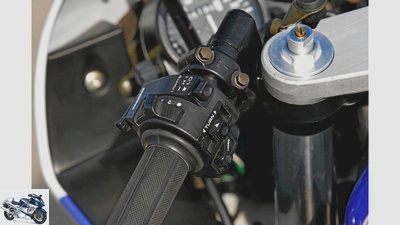
11/14
Light switch 1992.

12/14
Light switch 2012.
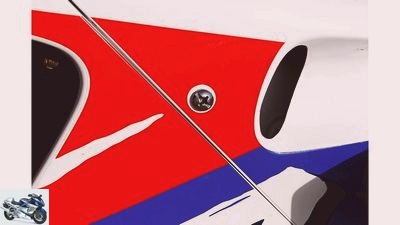
fact
13/14
Quick-release fasteners were still considered good form on the old Fireblade.
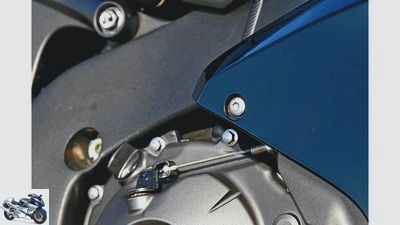
14/14
In 2012 the quick-release fasteners on the Honda Fireblade unfortunately disappeared.
Technology 20 years of progress in motorcycle construction
20 years of Fireblade: Part 1
Content of
20 years of Honda Fireblade mean 20 years of focused superbike development. PS examined the 1992 Honda CBR 900 RR and the current Fireblade, measured, tested and compared. So what does progress mean??
Honda presented the first at the end of 1991 F.ireblade and shook the athlete Olympus lastingly. Instead of 140 HP from 1000 cubic meters and a combat weight of 250 kilograms, as the competitors offered and expected, Honda offered 128 HP from 900 cubic meters with a sensational 208 kilograms vehicle mass – ready to drive and with a full tank, mind you!
The ingenious designer Tadao Baba left the beaten track of the competition with the CBR 900 RR Fireblade and limited himself to the essentials, the fun of driving, very Japanese. Instead of aiming for top values in performance or top speed, he reflected on what really makes motorcycling – the easy and playful handling of the pedestal. And thus laid the foundation for all modern sports motorcycles.
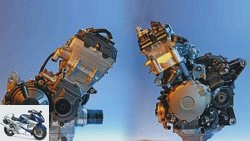
technology & future
Technology: 20 years of progress in engine technology
20 years of Fireblade: Part 2
read more
Honda Fireblade: old versus new.
Since the market launch of the CBR 900 RR, type SC 28, in February 1992, one thing has been made crystal clear in the world of athletes: performance is of no use if it cannot be controlled and used. The so-called “rideability”, the drivability of a motorcycle, rightly came more and more to the fore. What Baba managed to do purely mechanically on the SC 28 is now recorded by a large number of sensors on the BMW S 1000 RR and consorts, calculated in the engine control unit and presented to the driver in a well-educated and predictable manner. Otherwise, series bikes with around 200 hp would not be marketable.
But back to our Fireblades. Does the SC 28 have anything in common with the current SC 59 or can you even find direct traces of the grandma in the granddaughter? We start looking for constructive commonalities that can be used to document progress. First of all, the weight of the two blades catches the eye. In 20 years, the super sports car has only gained 2.3 kilograms, even though it is now 50 hp more, which requires a stiffer and more stable chassis, houses a C-ABS and also has to meet stricter emissions and noise regulations. When looking at individual components such as the fork tubes or the ready-to-install wheels with tires, it becomes clear: Material science and, above all, casting technology have made great progress. A tube from the USD 43 fork from the 2012 CBR weighs less than a tube from the 45 telescopic fork from the 1992 CBR with the same travel. The wheels of the SC 59 are massively lighter.The front wheel alone, at least one inch larger in diameter and equipped with two 320 mm instead of two 296 mm brake discs, is a whole kilo lighter than the 16-inch counterpart of the SC 28 Despite the widening of the rim from five and a half to six inches, the rear wheel still weighs 1.7 kilograms – including the larger rear tire (a table of weights for interesting components can be found on page 35). But being stingy with weight and maintaining it over the years does not produce the superior driveability with which the SC 28 once took to the field and which the SC 59 is still inherent in after 20 years. There is more to it than that, and the DNA of “easy going” must be found in the design of the chassis.
Weights
PS measurements in kg
archive
Basically, the SC 28 is still a modern motorcycle today. The swing arm could certainly be a little longer, but the entire package can justifiably be seen as the cornerstone of today’s super athletes.
In order to be able to precisely measure a motorcycle chassis, it must first be brought into the “zero position”. This means that the bike has to be lifted so far that it stands on the wheels with minimal contact with the ground without negative spring deflection. Then the real geometry can be recorded without the influence of the static negative spring travel and the position of the center of gravity, which is important for handling the bike, can be calculated. Even when measuring the standard values such as wheelbase, steering head angle, caster or swing arm length, there are the first aha experiences. The basic data of the SC 28 and the SC 59 are actually very close to one another. That means one degree difference in the steering head angle, seven millimeters difference in the caster, which is important for driving stability, and a rocker arm 67 millimeters longer and one degree steeper in the SC 59. Its crankshaft is eight millimeters higher than the SC 28, but its center of gravity ten millimeters lower.
Chassis data *
| SC 28/1992 | SC 59/2012 | |
| wheelbase | 1405 mm | 1422 mm |
| Steering head angle | 65.4 degrees | 66.4 degrees |
| trailing | 89 mm | 96 mm |
| Center of gravity height without driver | 518 mm | 508 mm |
| Weight with a full tank | 208.4 kg | 210.7 kg |
| Wheel load distribution without a driver | 51.0 / 49.0% | 51.8 / 48.2% |
| Wheel load distribution with driver ** | 46.6 / 53.4% | 48.3 / 51.7% |
| Arm length | 533 mm | 600 mm |
| Arm pivot height | 411 mm | 435 mm |
| Swing angle | 10.3 degrees | 11.3 degrees |
| Wheel radius front / rear. | 295/315 mm | 300/318 mm |
| Crankshaft height | 422 mm | 430 mm |
| Seat height | 830 mm | 855 mm |
| Handlebar height | 905 mm | 890 mm |
| Ergonomic triangle | ||
| Handlebar – footrest | 865 mm | 805 mm |
| Handlebar – bench | 725 mm | 675 mm |
| Bench – footrest | 440 mm | 430 mm |
* measured in the zero position, i.e. fully extended; ** spring loaded
Where does that come from? Due to the better mass concentration at the SC 59. This becomes apparent even to a layperson if he looks at the SC 28 from the side for a longer time. There is nothing directly below the edge of the tank seat, where the bracket for the rear frame extends from the main frame. Lots of air inside the main frame, which makes the SC 28 screwdriver-friendly. In granddaughter SC 59, this space is filled with tank and gear shaft. You read that correctly, because while the transmission shafts of the CBR 900 RR are one behind the other on one level, the package of the CBR 1000 engine is much tighter. The transmission shafts lie one above the other, which benefits the concentration of mass around the center of gravity and allows the swing arm to be 67 millimeters longer with a wheelbase that is only 17 millimeters longer. The SC 59 consistently pulls this compact design through. Another example of this is her silencer, which is 2.8 kilos heavier than on Grandma, but a) includes an exhaust flap and b) is not miles away from the center of gravity and thus has a negative impact on handling.
archive
The ergonomics of the SC 59 are not only more comfortable, the driver accommodation also has less influence on the entire motorcycle system. The center of gravity of the CBR 1000 RR is ten millimeters lower than that of the CBR 900 RR.
Another decisive factor in drivability – we leave out the topic of engine and power delivery here – is the accommodation of the pilot. A standard driver in Europe will sit down ready to drive in leather with 80 to 90 kilos in the seat cushion. That is over 40 percent of the vehicle’s own weight, which of course influences the driving behavior. The inclusion of this mass in the overall system is important, so the ergonomics of a bike is not only important in terms of comfort for the pilot, but also in terms of the overall driving characteristics. And this is exactly where the age of the SC 28 is most evident. While everything fits on the modern SC 59, the driver feels as comfortable as on the sofa at home and at most the very sporty knee angle can be criticized, when you get on the SC 28, a journey back in time begins. The popometer lands on the seat cushion deep behind the tank, and your arms stretch far over the tank, which is very bulbous in the upper part. In total, the distance from the footrest to the handlebar is 60 millimeters longer on the 900 RR than on the 1000 RR, and the distance from the measuring point on the seat to the handlebar end is exactly 50 millimeters longer. With the result that the driver on the SC 28 sits much further back. As a result, it influences the static wheel load distribution significantly more, the SC 28 becomes more tail-heavy, less precise and the driver loses feeling for the front wheel. The soft springs do not counteract this negative interference in the overall system enough, which is associated with the loss of freedom from inclination.
But is that all the grits and the old woman ripe for scrapping? The dynamic testing of the two blades took us to a former airfield, where the independent Motorcycle Test Center (MTC) has set up a handling track. This forest of pylons reflects the requirements of a nearby, winding country road and includes a fast slalom as well as a nasty hairpin bend. After the tires had been warmed up, both motorcycles went on ten timed laps. Then nine full brakes were driven and then several more laps on the circular track at the limit were completed. Of course, the test pilot always thundered around the course with the same commitment, which is proven by the very constant lap times in the data recording. And what do the records of the data logger reveal? Nothing but the bitter truth. But bitter for whom, the SC 28 or the SC 59? After the test drives, the author estimated the time difference to be two seconds, in favor of the new Fireblade, of course. Why? Because he a) had to use first gear at the acceleration points on the course and almost flew three times by highsider. It’s not fast, but it feels like it; b) the tighter basic setting of the CBR 1000 provides a great driving experience and c) there is plenty of lean angle available.
archive
Thanks to data recording, the driving dynamics of the SC 59 can be determined very precisely and the driver’s line can also be checked.
Back to the bitter truth. The 20-year-old CBR 900 RR loses just one second on the modern device on the tight handling course. Okay, of course this distance will increase as you run faster, but hats off to this performance. Who would have thought that a 20 year old grinder could be so fast. Especially since the limiting factors, namely the too soft chassis setting, the muddy brake lines and the insufficient ground clearance can be cured inexpensively. The situation is different with the handling of the 16-inch front wheel, which takes getting used to. When new, the Bridgestone S20 feels almost as good as its 17-inch counterpart on the CBR 1000. However, its erection moment in an inclined position is significantly greater and experience has shown that the target accuracy decreases sharply with increasing mileage of the skin. But that would be it. So, where is it now, the progress of the last 20 years? Generally in the refinement of the basic package that Tadao Baba laid with the CBR 900 RR in 1992. And of course in the engine and its performance. We will turn to this topic in the next issue of PS.
Thank you very much
This story would not have been possible without help. Thanks to Honda Wellbrock and Honda Speer – they provided parts and test vehicles. Bridgestone contributed the excellent S20 test tires, Mototech carried out a service on the SC 28 chassis and the Motorcycle Test Center (MTC) supported us with measurements and technical analysis.
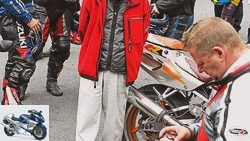
Sports & scene
Portrait: Tadao Baba
The father of the Honda Fireblade
read more
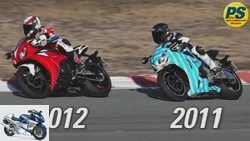
Super athlete
Driving report: Honda CBR 1000 RR Fireblade
Honda’s 2012 super sports car
read more

technology & future
Technology: 20 years of progress in engine technology
20 years of Fireblade: Part 2
read more
Handling course, setup and lap times
The editor and the analyst: Robert Gluck and Werner “Mini” Koch during the first evaluation of the data recording.
Setup race track
| Honda CBR 900 RR ’92 | Honda CBR 1000 RR ’12 | |
| fork | ||
| strat. neg. travel | 32 mm | 27 mm |
| Pressure level |
all damping settings counted from completely closed; static negative spring deflection standing vertically without driver; U = revolutions; K = clicks
2D measured values / lap times
| SC 28/1992 | SC 59/2012 | |
| Lap times handling course, length 829 meters | Best time: 50.15 s Ideal lap: 49.66 s |
Best time: 49.08 s
Ideal lap: 48.4 s
20 to 120 km / h
130 to 0 km / h
Braking distance 67.9 meters
Braking distance 69.3 meters
130 to 0 km / h
Braking distance 78.5 meters
Braking distance 71.6 meters
* without using the clutch; ** Lean angle calculated using GPS data without taking tire width and center of gravity into account
archive
De handling course for the Fireblade comparison.
PS data and measured values
The technical development of the last 20 years is clearly recognizable from the measured values.
Honda CBR 900 RR Fireblade SC 28
Drive:
Four-cylinder in-line engine, 4 valves / cylinder, 91 kW (128 PS) at 10500 / min *, 90 Nm at 8500 / min *, 893 cm³, bore / stroke: 70.0 / 58.0 mm, compression ratio: 11.1 : 1, Keihin constant pressure carburetor, 38 mm throttle bodies, mechanically operated multi-plate oil bath clutch, six-speed gearbox, chain
Landing gear:
Light alloy bridge frame, steering head angle: 66.0 degrees, caster: 89 mm, wheelbase: 1405 mm. Telescopic fork, Ø fork inner tube: 45 mm, adjustable in spring base and rebound. Central spring strut with deflection, adjustable in spring base, rebound and compression. Suspension travel front / rear: 120/120 mm
Wheels and brakes:
Light alloy cast wheels, 3.50 x 16 / 5.50 x 17, front tires: 130/70 ZR 16, rear: 180/55 ZR 17, test tires: Bridgestone S20. 296 mm double disc brake with four-piston fixed calipers at the front, 220 mm single disc with single-piston floating caliper at the rear
Measurements and weight:
Length / width / height: 2055/685/1110 mm, seat / handlebar height: 800/900 mm, handlebar width: 645 mm, 208 kg fully fueled, v./h .: 51.0 / 49.0% rear wheel power in the last gear 83 kW (113 PS) at 251 km / h
Consumption:
Fuel type: normal unleaded. Average test consumption: 6.3 liters / 100 km, tank capacity: 18 liters, range: 286 km
Base price:
19,750 marks (including ancillary costs 1992)
Honda Fireblade C-ABS SC 59
Drive:
Four-cylinder in-line engine, 4 valves / cylinder, 131 kW (178 PS) at 12000 / min *, 112 Nm at 8500 / min *, 1000 cm³, bore / stroke: 76.0 / 55.1 mm, compression ratio: 12.3 : 1, ignition / injection system, 46 mm throttle valves, mechanically operated multi-plate oil bath anti-hopping clutch, six-speed gearbox, G-Kat, chain
Landing gear:
Light alloy bridge frame, steering head angle: 66.8 degrees, caster: 96 mm, wheelbase: 1410 mm, upside-down fork, Ø fork inner tube: 43 mm, adjustable spring base, rebound and compression level. Central spring strut with deflection, adjustable in spring base, rebound and compression. Suspension travel front / rear: 120/138 mm
Wheels and brakes:
Light alloy cast wheels, 3.50 x 17 / 6.00 x 17, front tires: 120/70 ZR 17, rear: 190/50 ZR 17, test tires: Bridgestone S20, 320 mm double disc brakes with four-piston fixed calipers at the front, 220 mm single disc with single-piston floating caliper at the rear, C-ABS
Measurements and weight:
Length / width / height: 2090/830/1130 mm, seat / handlebar height: 815/860 mm, handlebar width: 650 mm, 211 kg with a full tank, v./h .: 51.8 / 48.2% rear wheel power in the last gear 118.5 kW (161 hp) at 248 km / h
Consumption:
Fuel type: Super unleaded. Average test consumption: 6.2 liters / 100 km., Tank capacity 17.7 liters, range: 285 km
Base price:
14990 euros including C-ABS (plus additional costs)
* Manufacturer information
archive
PS measured values of the Honda CBR 900 RR Fireblade SC 28 and the Honda Fireblade C-ABS SC 59.
PS readings
Uff, here a trained athlete demotes an aging ex-athlete. If it wasn’t on the diagram, you wouldn’t believe that the blue curve belongs to a 900. It is remarkable how effortlessly grandma’s new blade covers one. And that with just as good drivability and durability. The torque hanger of the CBR 900 RR between 5000 and 6000 tours is inconspicuous in everyday use, the engine run rougher and also more sluggish than on the modern engine. Here you can see the progress of the development very clearly.
Performance
| Acceleration** | Top speed * | |||||
| 0-100 km / h | 0-150 km / h | 0-200 km / h | 50-100 km / h | 100-150 km / h | ||
| Honda CBR 900 RR |
3.2 s | 5.3 s | 9.3 s | 5.1 s | 5.6 s | 254 km / h |
| Honda CBR 1000 RR |
3.2 s | 5.2 s | 7.5 s | 4.5 s | 3.6 s | 293 km / h |
* Manufacturer information, ** PS measurement

technology & future
Technology: 20 years of progress in engine technology
20 years of Fireblade: Part 2
read more
Technical background
Behind the scenes of comparing the Honda Fireblades.
From today’s perspective, the Honda CBR 900 RR from 1992 is a milestone designed by the expert hand of Tadao Baba. The Honda engineer countered the lavish handling of gawky technology and the unrestrained addition of materials by the competition with a spartan driving machine that was thought out down to the last detail. The delicate construction of the frame bridge alone, which only creates sufficient rigidity with the supporting function of the compact four-cylinder engine, is the consummate art of lightweight construction. This philosophy is also owed to the 45 mm telescopic fork, which, with its 3.9 kilograms per complete fork leg, displayed an almost flyweight lightness for that time, which is only undercut by the current USD fork with 43 mm dip tubes by only 500 grams.
Honda could afford the lightness of the CBR 900 RR because the engine power and torque were more economical than the around 140 hp and almost 250 kilograms Suzuki GSX-R 1100 or Yamaha FZR 1000. They drew on the full, during the Pioneer Tadao Baba was looking for the best compromise between power and handling – and found it at 125 hp and 208 kilograms.
The filigree Fireblade work of art was also allowed to be designed marginally in 1992 because there was no suitable racing class for the CBR 900 RR in Europe for which an extra portion of performance had to be taken into account. The CBR 1000 RR designers, on the other hand, have to proceed much more farsighted. Your motorcycle serves as the basis for the at least 220 hp racing engines of the Superbike World Championship and must at least compete there with a standard main frame.
If you compare the chassis data of the 20-year-old CBR with the current Fireblade from 2012, you can see the clear tendency towards more stability that the 50 hp more powerful engine demands. With the center of gravity only slightly lower (508 to 518 mm), not only did the wheelbase grow by 17 millimeters, but also the axle load distribution – especially when measuring with the driver – shows that sheer power is only usable when the front wheel is on the ground holds. Conversely, this means that the old, more tail-heavy CBR 900 RR slows down the new ABS model cleanly during the brake measurement at 9.6 m / s². But only if the rider perfectly balances the razor-sharp dance with the rear wheel slightly lifted, while the modern C-ABS Fireblade stands still on the point, even with gross motorized contemporaries.
The steering geometry, together with the center of gravity and mass concentration, the decisive factor in terms of handiness, is clearly in line with the trend of all supersport and MotoGP racing machines in the new model. That means: relatively long caster (96 to 89 mm), paired with a steeper steering head angle (66.4 to 65.4 degrees). The trend to equip some racing machines with extremely “manageable” values (up to 68 degrees steering head angle and 80 mm caster) has been broken for years and is approaching the values of road machines even in the MotoGP World Championship.
Conversely, the Honda CBR 1000 RR is based on the swing arm geometry of the 1000 MotoGP factory machines. The 600 millimeter long swing arm of the CBR 1000 RR is at a relatively steep angle of 11.3 degrees to the horizontal, while the only 533 millimeter short CBR 900 RR swing arm is mounted one degree flatter. The effect with steeply positioned swing arms and a correspondingly applied chain drive: the rear of the vehicle rebounds when accelerating in an inclined position and thus keeps the steering geometry in manageable dimensions. This so-called anti-squat effect – also known as pitch compensation – can be calculated using data such as the pivot point of the swing arm, sprocket size, swing arm length and center of gravity. According to this, the new Honda has 117 percent pitch compensation with 35 millimeters of negative suspension travel, while the old CBR 900 RR only has 107 percent pitch compensation. If the old Fireblade compresses up to 55 mm, the anti-squat effect is used up, after which the chain pulling force pulls the rear down. With the new CBR 1000 RR, this undesirable condition is only reached with a negative spring travel of 75 mm.
It is only the bundle of such measures that ultimately defines the progress of the great super athletes in detail. The times when you could file away a few seconds on the race track from one model year to the next are over since the ingenious milestone Honda Fireblade.

technology & future
Technology: 20 years of progress in engine technology
20 years of Fireblade: Part 2
read more
Related articles
-
Comparison test Honda Fireblade, VTR 1000 SP-2
Artistic comparison test Honda Fireblade, VTR 1000 SP-2 Everything stays different Honda is the only motorcycle manufacturer to produce two 1000cc super sports …
-
Honda CBR 1000 RR Fireblade SP in the test
Honda 22 pictures Honda 1/22 From the outside, there is hardly anything to suggest that Honda’s top athletes for 2014 will experience more than just visual retouching …
-
Honda CBR 1000 RR Fireblade 2012
Honda 16 pictures Youtube 1/16 Honda CBR 1000 RR Fireblade 2012 Youtube 2/16 Honda CBR 1000 RR Fireblade 2012 Youtube 3/16 Honda CBR 1000 RR Fireblade 2012 …
-
Honda CBR 1000 RR Fireblade SP in the PS driving report
Honda 21 pictures Honda 1/21 A completely new Fireblade was hoped for 2014. But Honda lets the Supersport fans fidget and only sends …
-
Honda Fireblade vs. Suzuki GSX-R 1000 in comparison test
Maccabelli The last four-cylinder without control electronics Test: Honda Fireblade against Suzuki GSX-R 1000 Contents of They are the last current …
-
Generation comparison: Honda RVF 750, Fireblade, Yamaha YZF-R7, YZF-R1
fact generation comparison: Honda and Yamaha Superbikes then and now in comparison Content of What can the noble homologation models of the …
-
Driving report Honda Fireblade SP
Honda 30th photos Honda 1/30 The adjusting screws of the rear Showa shock absorber are easily accessible. Honda 2/30 The 2017 new Honda Fireblade has…
-
Endurance test Honda CBR 1000 RR Fireblade SC77
Jorg Kunstle. 19 pictures Andreas Bildl 1/19 The ignition lock of the Fireblade no longer wants to give up the key – a little oil helps. Volkmar Jacob 2/19 …
-
Comparative test of athletes: BMW S 1000 RR against Honda Fireblade
13 Bilder Kunstle 1/13 The on-board tool kit of the BMW almost ties in with old traditions. With the help of the nine-piece set you can …
-
Technology highlights: Bimota Tesi, Honda NR 750, Norton TT
Jahn Technology highlights: Bimota Tesi, Honda NR 750, Norton TT Techno motorcycle The pace of further development in two-wheelers is getting faster and…